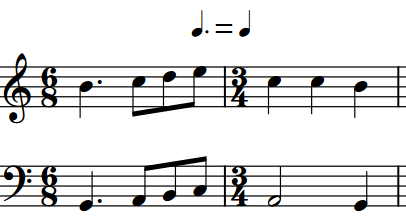

This defines the common workflow of notation software very well and for the most part, it all makes sense, but it takes some time to figure out where everything is. Dorico divides the workflow into five modes, which you’ll see along the top: Setup, Write, Engrave, Play, and Print. The interface is a clean, single window design with the music in the center and panels on the sides and bottom. To begin, create a new score, open an existing score or choose one of the templates provided. Comparisons of results are useful, but each program has its own best workflow and you simply must look for it. Having used, taught, and reviewed over a dozen notation programs in the past 25 years, I’ve learned it’s important to view a new program on its own terms. While all notation programs have similarities, Dorico is still different enough that it is helpful to leave behind most preconceptions. I recommend taking some extra time to look through each mode, especially the various gear icons (options), to get a feel for everything. Upon opening the program, you’ll be introduced to it through a tour. It would be nice if it were possible to have two installs, as many users need to work on both a laptop and desktop.

The program is copyprotected, but there’s no dongle required as long as you only run it on one machine. I can imagine those on slower Internet connections might get frustrated.
Dorico multi bar rests download#
Dorico comes on DVD or you can download it, though the download is a whopping 9 GB. It’s fast, fairly easy to use once you wrap your head around it and does some things, particularly layout, exceedingly well. My initial reaction is that Dorico is going to be a great program. To me that means a program that is fast and reasonably easy, handles a lot of common operations automatically, but is still flexible, produces good, functional copy, and one that can easily handle creating instructional materials. For this review, I’ll be looking at what I think is most important to teachers, composers and arrangers who write for school ensembles.

While most of us are satisfied with readable, functional copy, engravers will spend hours arguing over the shape of an 8th rest. Engravers are a particularly fussy bunch, much more so than the average user. Reviews of notation software generally center around the needs of engravers. If you don’t know the story, a few years back, Avid decided to let go of the Sibelius development team and Steinberg hired the core team to develop Dorico. Rarely has a software program been as anticipated as Steinberg’s new notation program. Please Click Here to Support SBO Magazine! We hope you continue to remain healthy during this most strenuous of times.

We at School Band & Orchestra wish nothing but the best for you, your school, your family and co-workers. Your consideration is greatly appreciated. It is with the utmost sincerity we ask you to consider supporting our efforts here with a small donation which will allow our staff the ability to keep these interesting stories about your chosen career coming to you in a consistent and timely basis. However, we would like your consideration in these difficult times to help support our efforts here at School Band & Orchestra to keep our information flowing and to provide you with a continuous stream of current and vital information when you need it the most.
Dorico multi bar rests for free#
We have been proud to bring School Band & Orchestra for free for more than two decades and we will continue to provide you with free subscriptions during the pandemic. We certainly understand times are tough for you, as it is for us. It is a strange and trying time for all of us in the midst of the COVID-19 pandemic.


 0 kommentar(er)
0 kommentar(er)
